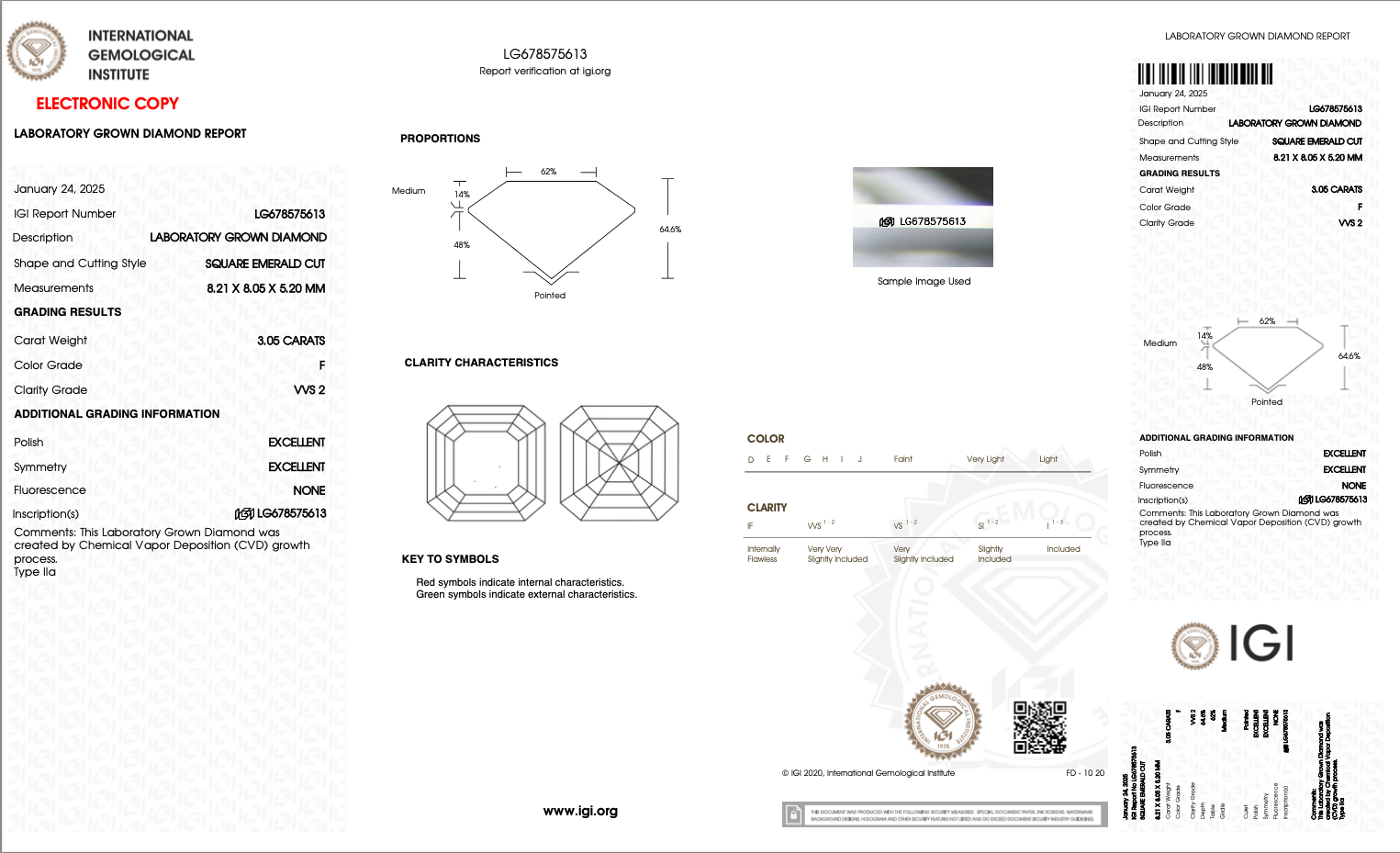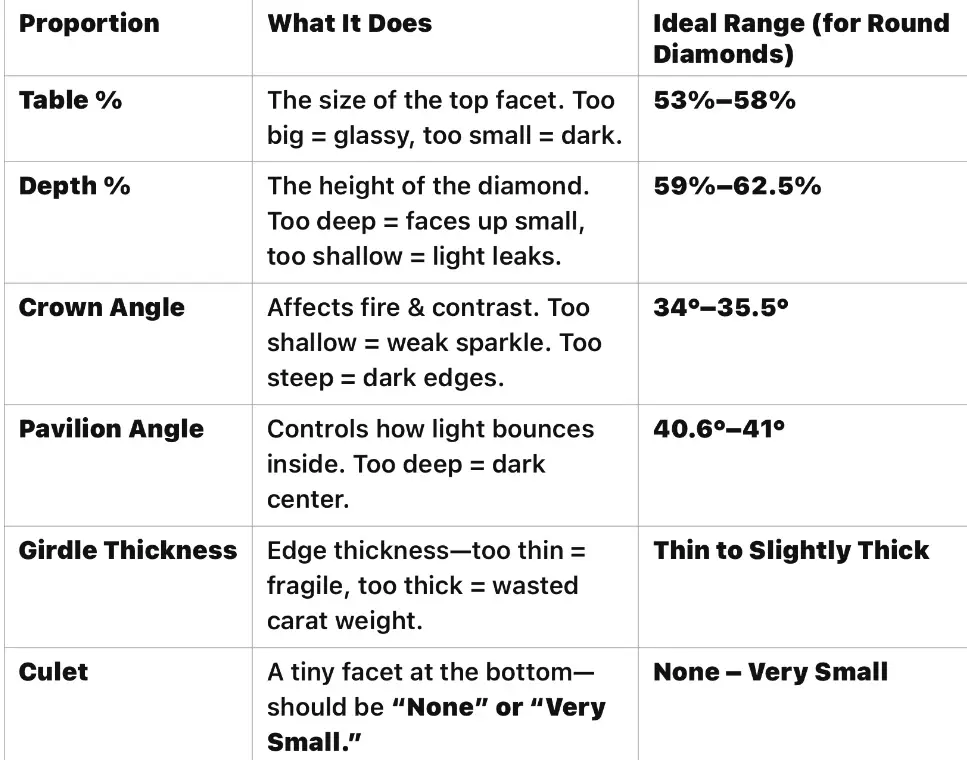If you’ve been shopping for a lab-grown diamond, chances are you’ve come across an IGI (International Gemological Institute) certificate. But how much of it actually matters? More importantly, how do you ensure you’re getting a diamond that looks stunning in real life, not just on paper?
Unlike GIA, the gold standard for natural diamonds, IGI is the most widely used lab for grading lab-grown diamonds. That said, IGI is known to be a little… generous. An IGI “E” color might actually be a GIA “F” or “G,” and an “Ideal” cut doesn’t always mean flawless light performance.
So, how do you make sense of an IGI certificate and use it to make an informed decision? Let’s break it down.

What Is an IGI Lab-Grown Diamond Certificate? #
An IGI certificate is a grading report that evaluates a diamond’s 4Cs (Carat, Color, Clarity, Cut), as well as proportions, fluorescence, polish, symmetry, and inclusions.
IGI has been grading diamonds for over 45 years and dominates the lab-grown diamond market because:
✅ Most jewelers sell IGI-certified stones—it’s the industry norm.
✅ Their reports provide key details to assess a diamond’s quality.
✅ They’re widely accepted by consumers and insurers.
However, IGI’s grading can sometimes be softer than GIA’s. You shouldn’t rely on the certificate alone—always check high-quality images and videos before buying.
How to Read an IGI Lab-Grown Diamond Certificate #
1. Identification Information #
This section includes:
- IGI Report Number – A unique number to verify online.
- Shape & Cutting Style – Round, oval, radiant, etc.
- Measurements – The diamond’s length, width, and depth in millimeters.
🚨 Pro Tip: Always verify the IGI report number online to confirm authenticity.
2. Grading Results (Color, Clarity & Cut—What Actually Matters) #
Color Grade: IGI Tends to Be Generous
- IGI’s color grading is a bit softer than GIA’s.
- An IGI “E” might be a GIA “F” or “G.”
- Color grades are fine for lab diamonds (especially when we can see they have been post-growth treated), but always check real-life images.
✅ Best Practice: Don’t obsess over the letter grade—see how the diamond looks in natural light.
Clarity Grade: What to Watch For
- IGI uses the same clarity scale as GIA (FL to I3) but is more lenient.
- An IGI VS1 might be closer to a GIA VS2 or even SI1. Don’t get hung up on this. Lab diamonds are created and treated in such a way that even if GIA were to grade them “lower,” you’re still likely getting a product that is aligned to a high standard of “eye clean.”
- Always review videos and high-resolution images before buying.
🚨 Warning: If the clarity is SI1 or lower, ensure there are no visible inclusions in the center of the stone.
Cut Grade: The Key to Sparkle
- IGI assigns a cut grade only to round diamonds.
- Their “Ideal” cut doesn’t always mean top-tier light performance.
- Proportions and light reflection matter more than the grade on paper.
🚨 For fancy shapes (ovals, pears, radiants, etc.), IGI doesn’t assign a cut grade—so check proportions and videos carefully.
3. Additional Grading Information #
These smaller details still matter:
- Polish – The smoothness of the surface. Look for “Excellent” or “Very Good.”
- Symmetry – How well the facets align. Again, “Excellent” or “Very Good” is best.
- Fluorescence – Some diamonds glow under UV light. None to Faint is ideal, but Medium/Strong isn’t necessarily a deal-breaker. BUT! This is only important for our colorless diamonds. If you’re looking for a colored diamond, you likely want a stone with at least slight fluorescence.
- Inscription – A laser-engraved serial number on the girdle for identification.
🚨 Red Flag: If polish or symmetry is below “Very Good,” craftsmanship might be subpar—better to skip.
Proportions: This Is What Really Matters #
The proportions section of the IGI report is where you can tell if a diamond is actually well-cut or just looks good on paper.

Clarity Characteristics (Where the Inclusions Are) #
This section includes a plotted diagram of inclusions—red symbols for internal flaws and green for external ones.
🚨 Biggest Mistake? Ignoring this.
- An SI1 diamond might have a noticeable black inclusion smack in the center.
- Always check the inclusion map and the actual video—clarity grades alone don’t tell the full story.
Why Reading an IGI Certificate Matters #
- Avoid Overpaying – IGI tends to be more forgiving than GIA, so don’t pay extra just for a higher grade.
- Verify Authenticity – Every IGI-certified diamond has a unique report number—always confirm it.
- Insurance Purposes – Many insurers require a grading report for coverage, so having one can save you hassle.
The Takeaway #
An IGI certificate is a useful tool, but it’s just one piece of the puzzle. A diamond’s real-world beauty comes down to more than just numbers—it’s about how it actually looks and performs. So, while the paperwork is important, always verify with high-quality images and videos before making a decision.
Because at the end of the day, it’s not about what’s on the report—it’s about what’s on your hand.


